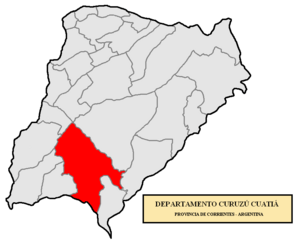Curuzú Cuatiá facts for kids
Quick facts for kids
Curuzú Cuatiá
|
|||
|---|---|---|---|
|
|||
 |
|||
| Country | |||
| Province | |||
| Department | Curuzú Cuatiá | ||
| Founded | November 16, 1810 | ||
| Elevation | 61 m (200 ft) | ||
| Population
(2010 census)
|
|||
| • Total | 34,470 | ||
| Demonym(s) | curuzucuateña/o | ||
| Time zone | UTC−3 (ART) | ||
| CPA base |
W3460
|
||
| Dialing code | +54 3774 | ||
| Website | Official website: http://www.curuzu.gov.ar/ | ||
Curuzú Cuatiá is a city located in the southern part of the Corrientes province in Argentina. It is part of a region called Argentine Mesopotamia. In 2010, about 34,000 people lived there. It is the main town of the Curuzú Cuatiá Department.
The land around the city is hilly. Many small rivers and streams flow through the area. These waters eventually reach the Paraná River to the west or the Uruguay River to the east. The weather here is a wet subtropical climate. This means it's warm and humid.
The city gets about 1,200 millimeters of rainfall each year. This rain is spread out evenly through the year. Average temperatures are around 14.5 °C in winter and 26 °C in summer. The coldest temperature ever recorded was −3 °C. The hottest was 44 °C.
Curuzú Cuatiá has its own airport. Its airport codes are UZU and SATU. The airport is located at 29°47′S 58°1′W / 29.783°S 58.017°W.
Contents
History of Curuzú Cuatiá
What Does the Name Mean?
The name Curuzú Cuatiá comes from the Guaraní language. It means "Engraved Cross." Early settlers, like Spanish conquistadores (explorers and conquerors) and Jesuit missionaries, called it Posta de Cruz. This was because the area was a busy crossroads. A large cross with a special message marked this important spot.
Founding the City
The May Revolution started Argentina's fight for independence from Spain. During this time, an army led by General Manuel Belgrano passed through the area. Belgrano helped solve a local government problem. He decided that the area would be under the control of the Cabildo (city council) of Corrientes.
On November 16, 1810, General Belgrano officially founded the city. He respected what the local people wanted and believed. So, he named the city Nuestra Señora de Pilar de Curuzú Cuatiá. This means "Our Lady of Pilar of Curuzú Cuatiá."
Important Battles and Growth
The area around Curuzú Cuatiá saw many important battles. These fights were part of a struggle between centralist and federalist groups in Argentina. One famous battle was the Battle of Pago Largo. This happened on March 31, 1839. It was fought against supporters of Juan Manuel de Rosas from Entre Ríos.
The town officially became a villa (a type of village) on October 9, 1852. Later, on October 25, 1888, it grew even more and became a full city.
Climate in Curuzú Cuatiá
The city of Curuzú Cuatiá has a warm and humid climate. Here is a summary of the weather data:
| Climate data for Curuzú Cuatiá (1981–1990) | |||||||||||||
|---|---|---|---|---|---|---|---|---|---|---|---|---|---|
| Month | Jan | Feb | Mar | Apr | May | Jun | Jul | Aug | Sep | Oct | Nov | Dec | Year |
| Mean daily maximum °C (°F) | 33.0 (91.4) |
30.7 (87.3) |
29.0 (84.2) |
25.1 (77.2) |
21.8 (71.2) |
18.4 (65.1) |
18.7 (65.7) |
21.0 (69.8) |
21.9 (71.4) |
25.9 (78.6) |
28.3 (82.9) |
31.4 (88.5) |
25.4 (77.7) |
| Daily mean °C (°F) | 26.9 (80.4) |
25.1 (77.2) |
23.3 (73.9) |
19.5 (67.1) |
16.3 (61.3) |
12.9 (55.2) |
12.7 (54.9) |
15.2 (59.4) |
16.2 (61.2) |
19.8 (67.6) |
22.7 (72.9) |
25.3 (77.5) |
19.7 (67.5) |
| Mean daily minimum °C (°F) | 19.8 (67.6) |
19.4 (66.9) |
17.3 (63.1) |
14.1 (57.4) |
10.5 (50.9) |
7.7 (45.9) |
7.3 (45.1) |
9.1 (48.4) |
10.3 (50.5) |
12.9 (55.2) |
16.1 (61.0) |
17.9 (64.2) |
13.5 (56.3) |
| Average precipitation mm (inches) | 123.9 (4.88) |
153.7 (6.05) |
152.3 (6.00) |
201.6 (7.94) |
99.9 (3.93) |
79.4 (3.13) |
50.1 (1.97) |
50.6 (1.99) |
112.2 (4.42) |
129.1 (5.08) |
132.2 (5.20) |
90.1 (3.55) |
1,375.1 (54.14) |
| Average precipitation days | 8 | 9 | 8 | 9 | 6 | 8 | 6 | 6 | 8 | 8 | 7 | 6 | 89 |
| Average relative humidity (%) | 62 | 72 | 73 | 79 | 79 | 82 | 79 | 74 | 75 | 69 | 69 | 61 | 73 |
| Source: Servicio Meteorologico Nacional | |||||||||||||
See also
 In Spanish: Curuzú Cuatiá para niños
In Spanish: Curuzú Cuatiá para niños




